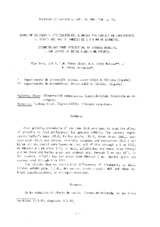Grado de molienda y utilización del alimento por conejos en crecimiento. I. Efecto del uso de tamices de 3 y 8 mm de diámetro
Grinding and food utilization by growing rabbits. I. The effect of using 3 and 8 mm sieves
Autor
Pérez Hernández, Manuel
Cejas Molina, M.A.
Pérez Alba, L.M.
Díaz Arca, J.F.
Editor
Universidad de Córdoba, Servicio de PublicacionesFecha
1989Materia
Retención de nitrógenoDigestibilidad
Conejos
Alimentación animal
METS:
Mostrar el registro METSPREMIS:
Mostrar el registro PREMISMetadatos
Mostrar el registro completo del ítemResumen
Four grinding procedures of the same diet were used to test the effect of grinding on food utilization for growing rabbits. The dietary ingredients (alfalfa hay: 480.0, barley grain: 189.0, wheat bran: 188.0, soybean meal: 82.0, and oleins, minerals, vitamins and bentonite: 61.0 g per kg on air dry basis) were hammer-milled, all of them through a 8 mm (TG), or through a 3 mm sieve (TF), or well, alfalfa hay and wheat bran through a 8 mm sieve and barley grain and soybean meal through 3 mm one (GF), or the reverse, alfalfa hay and wheat bran through 3 mm, barley grain and soybean meal through 8 mm (FG). The results show no statistical differences of treatments on daily intake, weight gain, F.C.R., dry matter, crude protein, NDF and ether extract digestibilities, or nitrogen retention. Se ha estudiado el efecto de varias formas de molienda de una misma dieta sobre su utilización por conejos en crecimiento. La composición de ingredientes de la dieta era: heno de alfalfa, 480,0; salvado de trigo, 188,0; cebada en grano, 189,0; torta de soja, 82,0; y oleínas, vitaminas, minerales y bentonita, 61,0 g/Kg La dieta se molió: a) toda con un tamiz de 8 mm (TG). b) alfalfa y salvado, por el tamiz de 8 mm; y cebada-soja, por un tamiz c) todo por un tamiz de 3 mm (FF); y d) alfalfa y salvado, por 3 mm; y cebada soja, por un-tamiz de 8 mm (FG). No se han encontrado diferencias significativas entre los tratamientos, sobre crecimiento, consumo de alimento, índices de conversión, digestibilidades de materia seca, proteína bruta, extracto etéreo, fibra neutro-detergente, ni sobre retención de nitrógeno.

